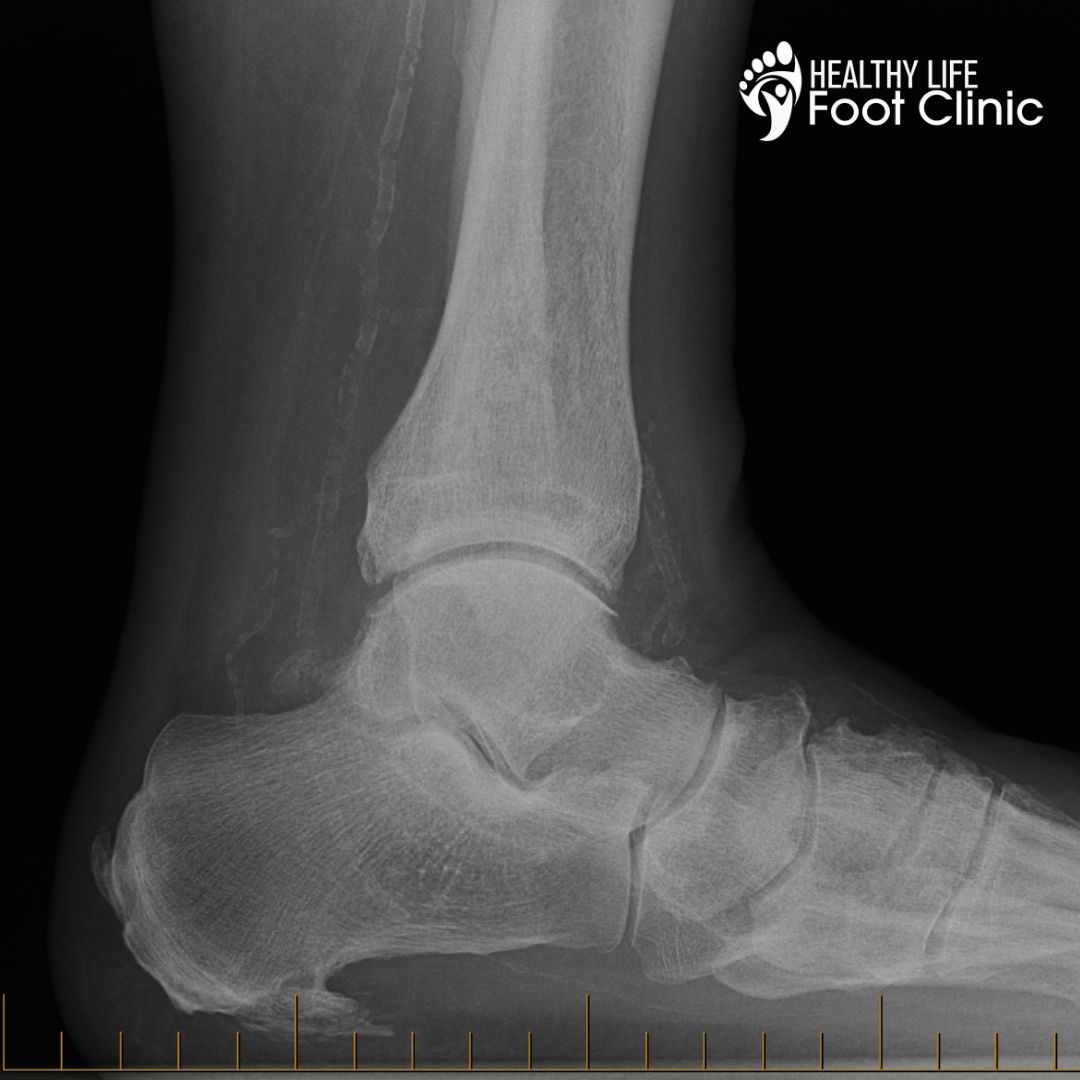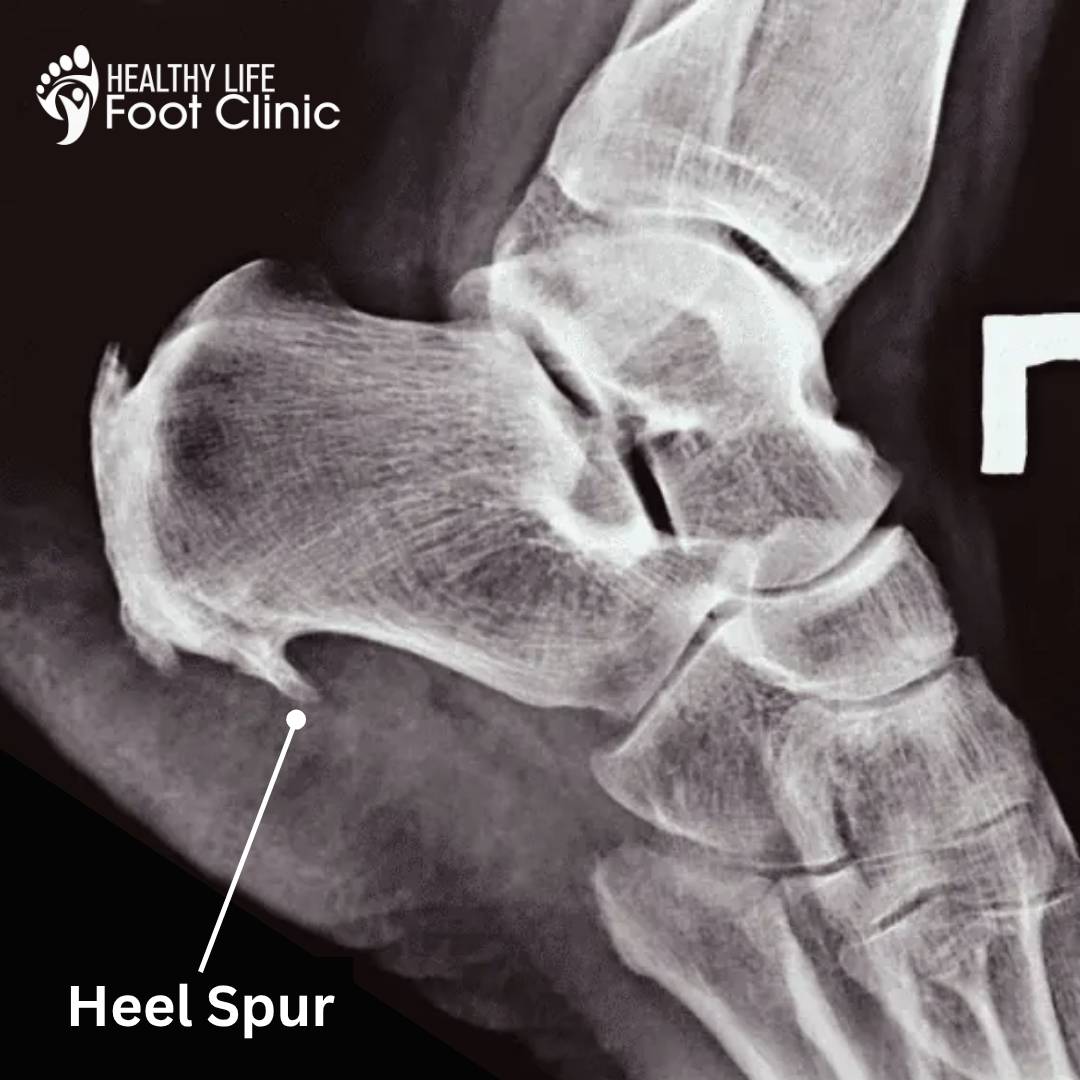What is a Heel Spur – and How Can You Treat It?
When heel pain has persisted for an extended period and hasn’t resolved on its own, the body may respond by reinforcing the area where the plantar fascia connects to the heel bone. This can result in a buildup of calcium—known as a heel spur—which essentially gives the plantar fascia a more solid anchor point. On its own, a heel spur typically doesn’t cause any issues.
However, if the tissues around the heel spur become inflamed or thickened, or if the spur itself becomes fractured, it can lead to significant discomfort—especially when walking or taking those first steps after rest.
In this blog, we’ll explain what heel spurs are, how they develop, whether they’re actually the source of your discomfort – and most importantly, what you can do about it.
So…What Is a Heel Spur?
A heel spur is a small bony growth that develops on the underside of the heel bone (calcaneus), often where the plantar fascia – the thick ligament that supports your arch – attaches. These spurs are usually the result of long-term strain and inflammation in the area, particularly from conditions like plantar fasciitis.
Contrary to popular belief, the spur itself is often not the direct cause of the pain. Many people have heel spurs that show up on X-rays but experience no symptoms at all.
The real issue? Usually the soft tissue structures around the heel, especially the plantar fascia, are inflamed, overloaded or thickened.
Need a Podiatrist for Heel Spurs?
Find Out More About Healthy Life Foot Clinic’s Care Guarantee
Contact Us or Book Online 24/7
What Causes Heel Spurs to Develop?
Heel spurs often form due to prolonged stress placed on the foot’s muscles and ligaments over time. Repetitive impact or strain—such as from activities like running, jumping, or standing for extended periods—can lead to their development. Carrying excess body weight also increases the load on the feet, making individuals more susceptible to this condition.
Several other factors can increase the likelihood of developing heel spurs, including:
Ageing: As people get older, the joints and soft tissues in the feet naturally wear down. These degenerative changes can contribute to the formation of spurs.
Inflammatory conditions: Chronic inflammatory disorders such as osteoarthritis, rheumatoid arthritis, or gout can encourage abnormal bone growth, including spurs.
Inadequate footwear: Wearing shoes that lack proper support or cushioning can lead to excess stress on the heel and contribute to spur formation.
It’s worth noting that not everyone exposed to these risk factors will develop heel spurs. Moreover, heel spurs themselves are rarely the direct cause of pain. Instead, they usually indicate that inflammation or stress has been affecting the area for some time.
What are the Symptoms of Heel Spurs?
In most cases, heel spurs are harmless and don’t cause any noticeable discomfort. Many people only become aware of them incidentally—often when having an x-ray done for an unrelated issue. One rare exception is if the spur becomes fractured, which can lead to pain. However, the discomfort people typically associate with heel spurs is usually due to irritation or inflammation in the nearby soft tissues rather than the spur itself.
Heel spurs often form as a result of repeated stress and injury to the tissue at the base of the heel. The body responds by creating scar tissue to repair the area, but if healing isn’t successful, it may begin to deposit calcium in an attempt to stabilise and protect the site—eventually forming a spur.
The hallmark symptom of heel pain is a sharp, stabbing pain beneath the heel, especially when standing up after rest, walking, or standing for prolonged periods. This pain is often most intense with the first steps in the morning or after sitting down for a while. It may also radiate into the arch or forefoot in some cases.
Additional signs of heel-related problems can include:
– Swelling or tenderness in the heel
– Redness or a warm sensation in the area
– Limited movement in the foot or ankle
If these symptoms sound familiar, it’s best to consult a podiatrist for a proper diagnosis and treatment plan.
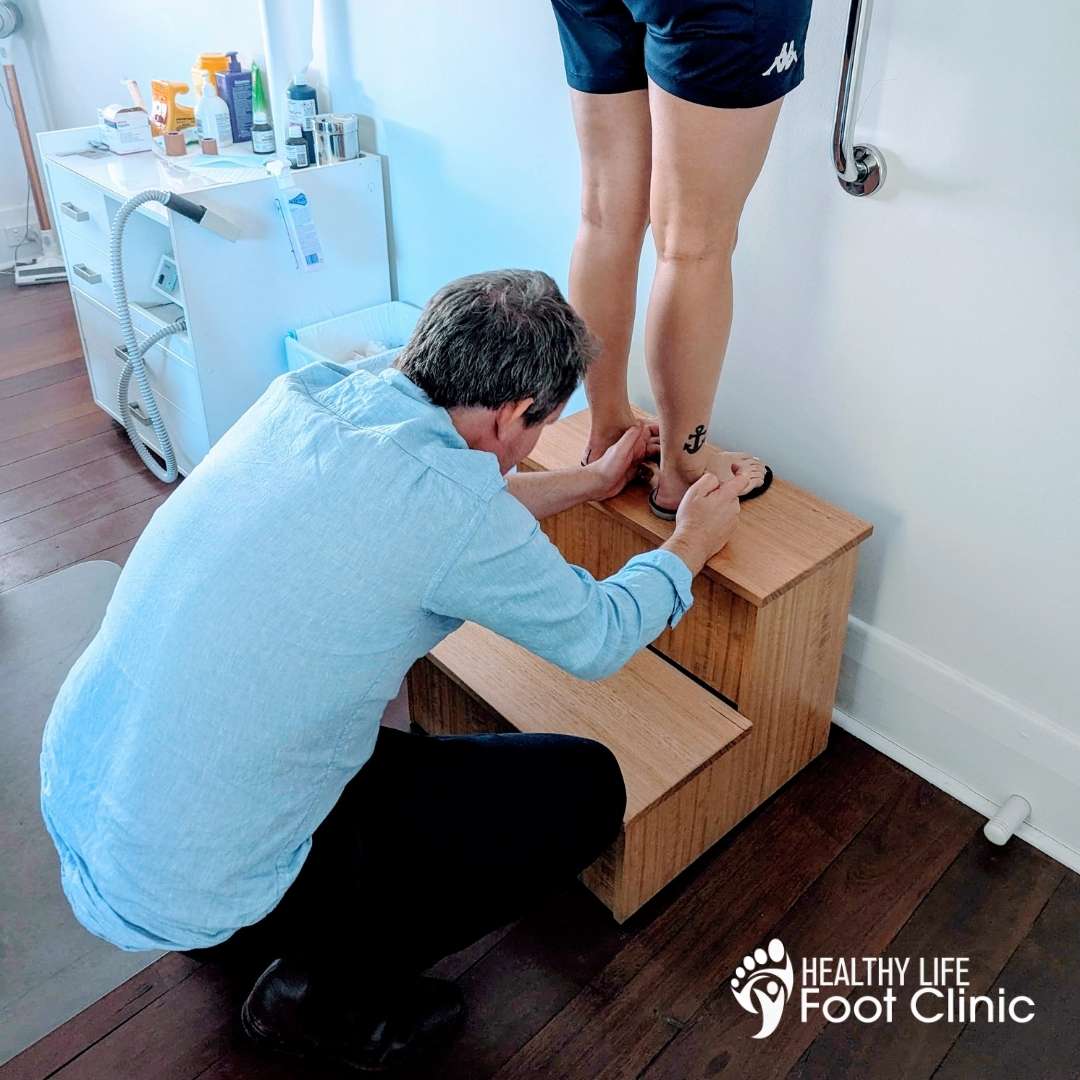
How are Heel Spurs Diagnosed?
Diagnosing heel spurs often involves imaging techniques like X-rays or, in some cases, MRI scans.
When assessing heel pain, a podiatrist will begin with a thorough physical examination and a discussion of your medical history. If needed, they may recommend imaging to get a clearer picture of what’s happening inside the foot. X-rays frequently reveal heel spurs, although these are often found by chance while investigating other concerns.
During the physical exam, you may be asked to walk or stand so your podiatrist can observe your gait and identify any visible signs of swelling or irritation. They will also palpate various areas of your foot to locate any points of tenderness or discomfort. Additional assessments might include checking joint movement, muscle strength, and flexibility.
Using the information gathered from the physical exam, taping trials, and any imaging conducted, your podiatrist can accurately diagnose the source of your heel pain and tailor a treatment plan to address it effectively.
Do I Need Surgery to Remove a Heel Spur?
In most cases, no. Surgery to remove a heel spur is very rare and usually unnecessary.
Because the pain is usually related to inflammation of the plantar fascia or surrounding soft tissues, the focus of treatment is to reduce strain, improve foot mechanics, and help the tissues heal.
Need a Podiatrist for Heel Spurs?
Find Out More About Healthy Life Foot Clinic’s Care Guarantee
Contact Us or Book Online 24/7
What are the Treatment Options?
If a heel spur becomes fractured, it typically requires treatment similar to that of any bone fracture. However, in most cases, heel spurs that aren’t causing symptoms don’t need any intervention.
When heel pain is present—whether or not a heel spur is involved—a range of treatment strategies may be used to reduce discomfort, support healing, and prevent recurrence. These include:
- Taking a break from activities that aggravate the pain
- Applying ice to calm inflammation
- Supportive taping or strapping techniques
- Targeted exercises to stretch and strengthen the foot and lower leg
- Guidance on modifying activity levels or training loads
- Manual therapy such as joint mobilisation
- Advice on appropriate footwear
- Custom orthotic devices to reduce stress on the heel
- Shockwave therapy (ESWT) to promote tissue repair
- Dry needling to relieve muscular tension
- Cortisone injections for severe inflammation and pain
- Surgical intervention (only considered in persistent, unresponsive cases)
In most situations, a combination of these conservative approaches is enough to manage symptoms effectively. Surgery is rarely needed, and the primary aim of treatment is to reduce pain, address inflammation, and prevent the condition from worsening over time.
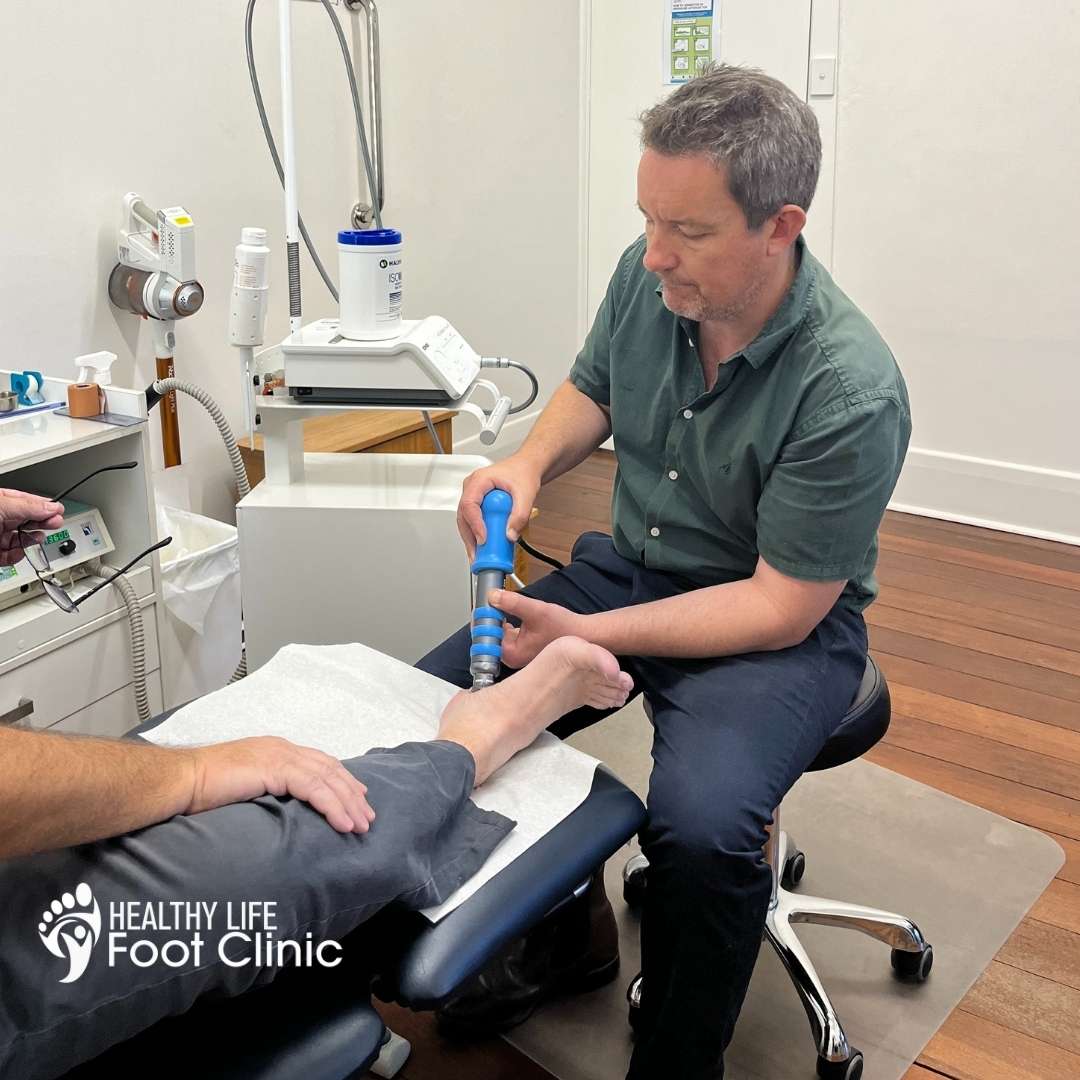
Can Stretching or Exercise Help Relieve Discomfort from Heel Spurs?
While certain exercises can play a valuable role in easing heel pain, it’s important to understand that stretching alone won’t eliminate a heel spur itself. Rather, the goal is to improve mobility, reduce tension, and support healing in the surrounding tissues.
Helpful exercises often include calf stretches, plantar fascia stretches, towel scrunches, and toe mobility work. These movements can help reduce strain on the heel and improve foot function over time.
It’s essential to work with a podiatrist who understands the underlying causes of your heel pain. Exercise programs must be tailored to your individual needs, taking into account the timing, intensity, and frequency that’s right for your situation.
Ultimately, how effective these exercises are depends heavily on correct technique and appropriate loading—both of which a podiatrist can guide you through to ensure the best possible results.
Need a Podiatrist for Heel Spurs?
Find Out More About Healthy Life Foot Clinic’s Care Guarantee
Contact Us or Book Online 24/7
Is it Possible to Prevent Heel Spurs?
Although it’s not always possible to completely avoid developing heel spurs, there are several ways to lower your risk and protect your feet from excessive stress:
- Choose well-fitted shoes that offer proper support and cushioning
- Avoid jumping into high-impact activities too quickly—build up gradually
- Increase the intensity and duration of physical activity over time
- Maintain a healthy body weight to reduce pressure on your feet
- Incorporate regular stretching and strengthening exercises to enhance foot flexibility and resilience
By taking proactive steps in your daily routine, you can help minimise the likelihood of heel-related issues and keep your feet functioning well for longer.
Are Heel Spurs and Plantar Fasciitis the same thing?
No—they’re different conditions, though they often appear together. Plantar fasciitis involves inflammation of the thick band of tissue along the bottom of the foot, whereas a heel spur is a calcium deposit or bony outgrowth near the heel bone. A heel spur doesn’t always lead to pain and is frequently found incidentally.
Can a Heel Spur disappear on its own?
Heel spurs don’t dissolve or go away naturally, but they’re rarely the direct source of pain. Instead, treatment usually targets the underlying issues—such as inflammation or tissue strain—rather than the spur itself. Accurate diagnosis is essential so that the treatment plan can address the true cause of the discomfort.
Can Heel Pain or Heel Spurs return after Treatment?
Yes, heel pain and the symptoms related to heel spurs can come back—especially if the root causes aren’t properly addressed. If issues like plantar fasciitis recur, the discomfort may return as well. That’s why maintaining good habits and continuing with preventive strategies is essential, even after symptoms improve.
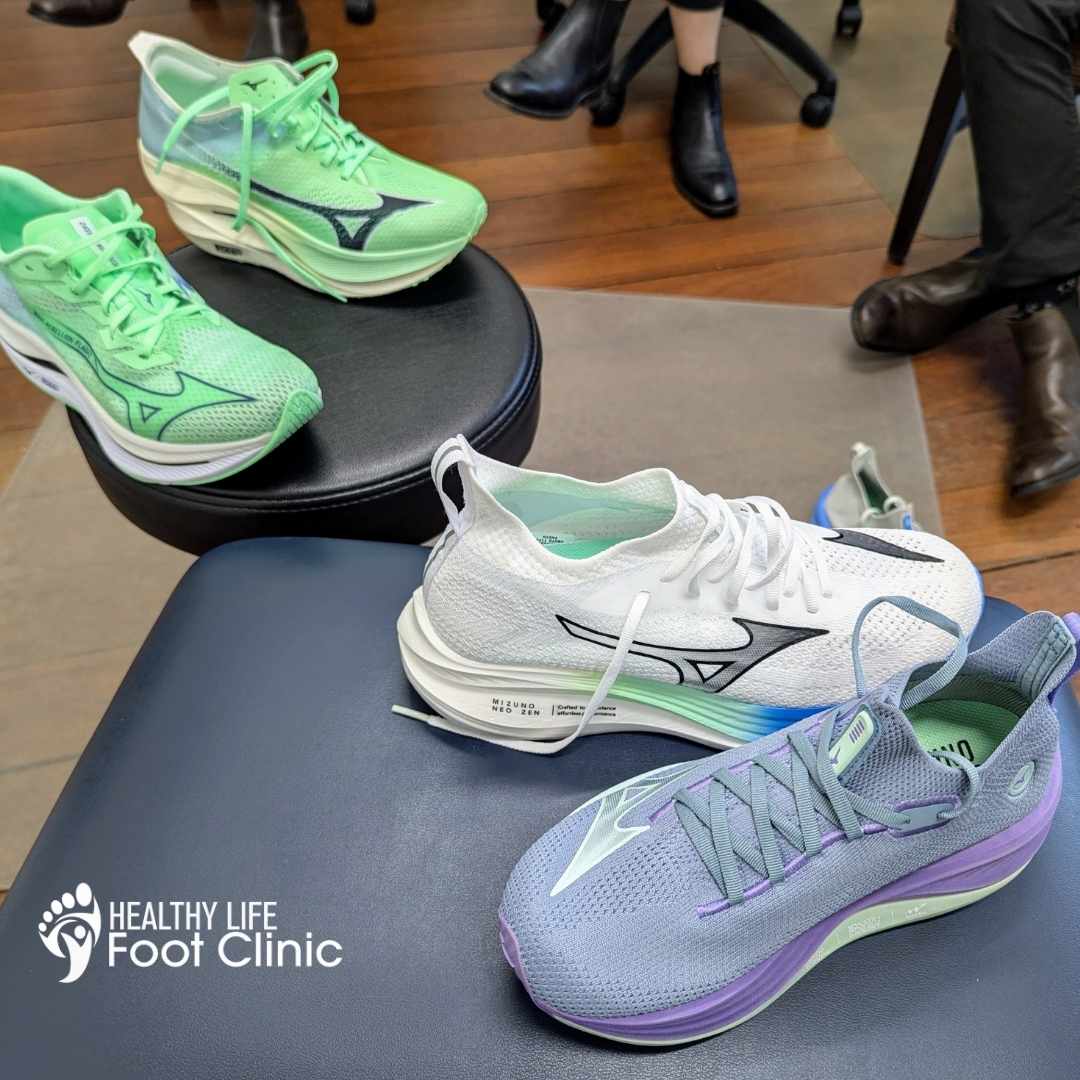
Are there any Risks or Complications Linked to Heel Spurs?
On their own, heel spurs usually aren’t harmful. However, if they become irritated, traumatised, or fractured, they can lead to ongoing pain and functional limitations.
Can Footwear or Orthotics Help Manage Heel Spurs?
Absolutely. Wearing shoes that provide good cushioning and arch support can help reduce stress on the heel and alleviate symptoms. In many cases, orthotic inserts—whether off-the-shelf or custom-made—can improve foot alignment, offload pressure from the heel, and support better overall foot function.
As always, it’s important to seek advice from a qualified podiatrist. A proper diagnosis is key to tailoring a treatment approach that’s suited to your specific condition and long-term foot health.
Final Thoughts
Heel spurs and the heel pain they may contribute to can be frustrating and limiting—but with accurate diagnosis, effective treatment, and ongoing preventive care, most people can regain comfortable, pain-free movement without needing surgery.
Whether you’re active in sport or simply spend long hours on your feet, it’s important not to ignore persistent heel discomfort. A visit to a podiatrist can help identify the cause and guide you toward the right management plan for lasting relief.
Need a Podiatrist for Heel Spurs?
Find Out More About Healthy Life Foot Clinic’s Care Guarantee
Contact Us or Book Online 24/7

